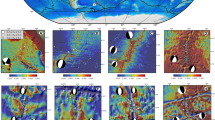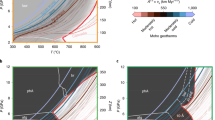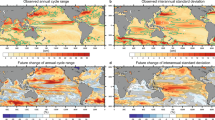Abstract
Earth’s surface topography is a direct physical expression of our planet’s dynamics. Most is isostatic, controlled by thickness and density variations within the crust and lithosphere, but a substantial proportion arises from forces exerted by underlying mantle convection. This dynamic topography directly connects the evolution of surface environments to Earth’s deep interior, but predictions from mantle flow simulations are often inconsistent with inferences from the geological record, with little consensus about its spatial pattern, wavelength and amplitude. Here, we demonstrate that previous comparisons between predictive models and observational constraints have been biased by subjective choices. Using measurements of residual topography beneath the oceans, and a hierarchical Bayesian approach to performing spherical harmonic analyses, we generate a robust estimate of Earth’s oceanic residual topography power spectrum. This indicates water-loaded power of 0.5 ± 0.35 km2 and peak amplitudes of up to ~0.8 ± 0.1 km at long wavelengths (~104 km), decreasing by roughly one order of magnitude at shorter wavelengths (~103 km). We show that geodynamical simulations can be reconciled with observational constraints only if they incorporate lithospheric structure and its impact on mantle flow. This demonstrates that both deep (long-wavelength) and shallow (shorter-wavelength) processes are crucial, and implies that dynamic topography is intimately connected to the structure and evolution of Earth’s lithosphere.
This is a preview of subscription content, access via your institution
Access options
Access Nature and 54 other Nature Portfolio journals
Get Nature+, our best-value online-access subscription
$29.99 / 30 days
cancel any time
Subscribe to this journal
Receive 12 print issues and online access
$259.00 per year
only $21.58 per issue
Buy this article
- Purchase on Springer Link
- Instant access to full article PDF
Prices may be subject to local taxes which are calculated during checkout



Similar content being viewed by others
Data availability
The compilation of observational constraints on residual topography used herein, which builds on the database and methodology of Hoggard et al.41, is available at https://github.com/drhodrid/Davies_etal_NGeo_2019_Datasets. Synthetic topography predictions from our geodynamical simulations are also included.
Code availability
Fluidity is available under the GNU Lesser General Public License. The source code and manual can be found at: http://fluidityproject.org. The optimal regularization routines utilized for our spherical harmonic analyses are available from: https://github.com/valentineap/optimal-regularisation.
References
Davies, G. F. Dynamic Earth: Plates, Plumes and Mantle Convection (Cambridge Univ. Press, 1999).
Pekeris, C. L. Thermal convection in the interior of the Earth. Geophys. J. 3, 343–367 (1935).
Parsons, B. & Daly, S. The relationship between surface topography, gravity anomalies, and temperature structure of convection. J. Geophys. Res. 88, 1129–1144 (1983).
Richards, M. A. & Hager, B. H. Geoid anomalies in a dynamic Earth. J. Geophys. Res. 89, 5987–6002 (1984).
Hager, B. H. & Richards, A. M. Long–wavelength variations in Earth’s geoid: physical models and dynamical implications. Philos. Trans. R. Soc. Lond. A 328, 309–327 (1989).
Cazenave, A., Souriau, A. & Dominh, K. Global coupling of Earth’s surface topography with hotspots, geoid and mantle heterogeneities. Nature 340, 54–57 (1989).
Braun, J. The many surface expressions of mantle dynamics. Nat. Geosci. 3, 826–833 (2010).
Flament, N., Gurnis, M. & Muller, R. D. A review of observations and models of dynamic topography. Lithosphere 5, 189–210 (2013).
Hoggard, M. J., White, N. & Al-Attar, D. Global dynamic topography observations reveal limited influence of large-scale mantle flow. Nat. Geosci. 9, 456–463 (2016).
Lithgow-Bertelloni, C. & Silver, P. G. Dynamic topography, plate driving forces and the African superswell. Nature 395, 269–272 (1998).
Colli, L., Ghelichkhan, S. & Bunge, H.-P. On the ratio of dynamic topography and gravity anomalies in a dynamic Earth. Geophys. Res. Lett. 43, 2510–2516 (2016).
Burgess, P. M. & Gurnis, M. Mechanisms for the formation of cratonic stratigraphic sequences. Earth Planet. Sci. Lett. 136, 647–663 (1995).
Petersen, K. D., Nielsen, S., Clausen, O., Stephenson, R. & Gerya, T. Small-scale mantle convection produces stratigraphic sequences in sedimentary basins. Science 329, 827–830 (2010).
Shephard, G. E., Muller, R. D., Liu, L. & Gurnis, M. Miocene drainage reversal of the Amazon River driven by plate–mantle interaction. Nat. Geosci. 3, 870–875 (2010).
Roberts, G. G. & White, N. J. Estimating uplift rate histories from river profiles using African examples. J. Geophys. Res. 115, B02406 (2010).
Czarnota, K., Hoggard, M. J., White, N. & Winterbourne, J. Spatial and temporal patterns of Cenozoic dynamic topography around Australia. Geochem. Geophys. Geosys. 14, 634–658 (2013).
Czarnota, K., Roberts, G. G., White, N. J. & Fishwick, S. Spatial and temporal patterns of Australian dynamic topography from river profile modelling. J. Geophys. Res. 119, 1384–1419 (2014).
Eakin, C., Lithgow-Bertelloni, C. & Davila, F. M. Influence of Peruvian flat-subduction dynamics on the evolution of western Amazonia. Earth Planet. Sci. Lett. 404, 250–260 (2014).
Mitrovica, J. X., Beaumont, C. & Jarvis, G. T. Tilting of continental interiors by the dynamical effects of subduction. Tectonics 8, 1079–1094 (1989).
Gurnis, M. Phanerozoic marine inundation of continents driven by dynamic topography above subducting slabs. Nature 364, 589–593 (1993).
Moucha, R. et al. Dynamic topography and long-term sea-level variations: there is no such thing as a stable continental platform. Earth Planet. Sci. Lett. 271, 101–108 (2008).
Crameri, F. & Lithgow-Bertelloni, C. Abrupt upper-plate tilting during slab-transition-zone collision. Tectonophys 746, 199–211 (2018).
Cao, W., Flament, N., Zahirovic, S., Williams, S. & Muller, R. D. The interplay of dynamic topography and eustasy on continental flooding in the late Paleozoic. Tectonophysics 761, 108–121 (2019).
Molnar, P. & England, P. Late Cenozoic uplift of mountain ranges and global climate change: chicken and egg? Nature 346, 29–34 (1990).
Crough, S. T. Hotspot swells. Ann. Rev. Earth Planet. Sci. 11, 165–193 (1983).
Panasyuk, S. V. & Hager, B. H. Models of isostatic and dynamic topography, geoid anomalies, and their uncertainties. J. Geophys. Res. 105, 28199–28209 (2000).
Kaban, M. K., Schwintzer, P., Artemieva, I. M. & Mooney, W. D. Density of the continental roots: compositional and thermal contributions. Earth Planet. Sci. Lett. 209, 53–69 (2003).
Guerri, M., Cammarano, F. & Tackley, P. J. Modelling Earth’s surface topography: decomposition of the static and dynamic components. Phys. Earth Planet. Int. 261, 172–186 (2016).
Ricard, Y., Richards, M. A., Lithgow-Bertelloni, C. & LeStunff, Y. A geodynamic model of mantle mass heterogeneities. J. Geophys. Res. 98, 21895–21909 (1993).
Steinberger, B. Effects of latent heat release at phase boundaries on the flow in the Earth’s mantle, phase boundary topography and the dynamic topography at the Earth’s surface. Phys. Earth Planet. Int. 164, 2–20 (2007).
Conrad, C. & Husson, L. Influence of dynamic topography on sea level and its rate of change. Lithosphere 1, 110–120 (2009).
Yang, T. & Gurnis, M. Dynamic topography, gravity and the role of lateral viscosity variations from inversion of global mantle flow. Geophys. J. Int. 207, 1186–1201 (2016).
Rubey, M. et al. Global patterns in Earth’s dynamic topography since the Jurassic: the role of subducted slabs. Solid Earth 8, 899–919 (2017).
Colli, L., Ghelichkhan, S., Bunge, H.-P. & Oeser, J. Retrodictions of Mid Paleogene mantle flow and dynamic topography in the Atlantic region from compressible high resolution adjoint mantle convection models:sensitivity to deep mantle viscosity and tomographic input model. Gondwana Res. 53, 252–272 (2018).
Eakin, C. & Lithgow-Bertelloni, C. in Mountains, Climate and Biodiversity (eds Hoorn, C. et al.) Ch. 3 (Wiley, 2018).
Molnar, P., England, P. C. & Jones, C. H. Mantle dynamics, isostasy, and the support of high terrain. J. Geophys. Res. 120, 1932–1957 (2015).
Crosby, A. G. & McKenzie, D. An analysis of young ocean depth, gravity and global residual topography. Geophys. J. Int. 178, 1198–1219 (2009).
Hager, B. H. Subducted slabs and the geoid: constraints on mantle rheology and flow. J. Geophys. Res. 89, 6003–6015 (1984).
Steinberger, B. Topography caused by mantle density variations: observation-based estimates and models derived from tomography and lithosphere thickness. Geophys. J. Int. 205, 604–621 (2016).
Laske, G., Masters, G., Ma, Z. & Pasyanos, M. Update on CRUST1.0—a 1-degree global model of Earth’s crust. Geophys. Res. Abstr. 15, abst. EGU2013–2658 (2013).
Hoggard, M. J., Winterbourne, J., Czarnota, K. & White, N. Oceanic residual depth measurements, the plate cooling model, and global dynamic topography. J. Geophys. Res. 122, 2328–2372 (2017).
Watkins, C. E. & Conrad, C. P. Constraints on dynamic topography from asymmetric subsidence of the mid-ocean ridges. Earth Planet. Sci. Lett. 484, 264–275 (2018).
Arnould, M., Coltice, N., Flament, N., Seigneour, V. & Muller, R. D. On the scales of dynamic topography in whole-mantle convection models. Geochem. Geophys. Geosys. 19, 3140–3163 (2018).
Steinberger, B., Conrad, C. P., Osei Tutu, A. & Hoggard, M. J. On the amplitude of dynamic topography at spherical harmonic degree two. Tectonophysics 760, 221–228 (2019).
Yang, T., Moresi, L., Muller, R. D. & Gurnis, M. Oceanic residual topography agrees with mantle flow predictions at long wavelengths. Geophys. Res. Lett. 44, 10896–10906 (2017).
Valentine, A. P. & Sambridge, M. Optimal regularisation for a class of linear inverse problem. Geophys. J. Int. 215, 1003–1021 (2018).
Tarantola, A. & Valette, B. Generalised non-linear inverse problems solved using the least squares criterion. Rev. Geophys. Space Phys. 20, 219–232 (1982).
MacKay, D. Bayesian interpolation. Neural Comput. 4, 415–447 (1992).
Spasojevic, S. & Gurnis, M. Sea level and vertical motion of continents from dynamic Earth models since the Late Cretaceous. Am. Assoc. Petrol. Geol. Bull. 10, 2037–2064 (2012).
Afonso, J. C., Salajegheh, F., Szwillus, W., Ebbing, J. & Gaina, C. A global reference model of the lithosphere and upper mantle from joint inversion and analysis of multiple data sets. Geophys. J. Int. 217, 1602–1628 (2019).
Davies, D. R., Wilson, C. R. & Kramer, S. C. Fluidity: a fully unstructured anisotropic adaptive mesh computational modelling framework for geodynamics. Geochem. Geophys. Geosys. 120, Q06001 (2011).
Kramer, S. C., Wilson, C. R. & Davies, D. R. An implicit free-surface algorithm for geodynamical simulations. Phys. Earth Planet. Int. 194, 25–37 (2012).
Davies, D. R. & Rawlinson, N. On the origin of recent intra-plate volcanism in Australia. Geology 42, 1031–1034 (2014).
Davies, D. R., Le Voci, G., Goes, S., Kramer, S. C. & Wilson, C. R. The mantle wedge’s transient 3-D flow regime and thermal structure. Geochem. Geophys. Geosys. 17, 78–100 (2016).
Zhong, S., McNamara, A., Tan, E., Moresi, L. & Gurnis, M. A benchmark study on mantle convection in a 3-D spherical shell using CitcomS. Geochem. Geophys. Geosys. 9, Q10017 (2008).
Tackley, P. J. Modelling compressible mantle convection with large viscosity contrasts in a three-dimensional spherical shell using the Yin-Yang grid. Phys. Earth Planet. Int. 171, 7–18 (2008).
Davies, D. R. et al. A hierarchical mesh refinement technique for global 3D spherical mantle convection modelling. Geosci. Mod. Dev. 6, 1095–1107 (2013).
Ritsema, J., van Heijst, H. J., Deuss, A. & Woodhouse, J. H. S40RTS: a degree-40 shear-velocity model for the mantle from new Rayleigh wave dispersion, teleseismic traveltime, and normal-mode splitting function measurements. Geophys. J. Int. 184, 1223–1236 (2011).
Richards, F. D., Hoggard, M. J., Cowton, L. R. & White, N. J. Reassessing the thermal structure of oceanic lithosphere with revised global inventories of basement depths and heat flow measurements. J. Geophys. Res. 123, 9136–9161 (2018).
Davies, D. R., Rawlinson, N., Iaffaldano, G. & Campbell, I. H. Lithospheric controls on magma composition along Earth’s longest continental hotspot track. Nature 525, 511–514 (2015).
Schaeffer, A. J. & Lebedev, S. Global shear speed structure of the upper mantle and transition zone. Geophys. J. Int. 194, 417–449 (2013).
Steinberger, B. & Becker, T. W. A comparison of lithospheric thickness models. Tectonophysics 746, 325–338 (2018).
Kaban, M. K., Tesauro, M., Mooney, W. D. & Cloetingh, S. A. P. L. Density, temperature, and composition of the North American lithosphere—new insights from a joint analysis of seismic, gravity, and mineral physics data: 1. Density structure of the crust and upper mantle. Geochem. Geophys. Geosyst. 15, 4781–4807 (2014).
Jordan, T. H. Composition and development of the continental tectosphere. Nature 274, 544–548 (1978).
Griffin, W. L., O’Reilly, S. Y., Afonso, J. C. & Begg, G. C. The composition and evolution of lithospheric mantle: a re-evaluation and its tectonic implications. J. Petrol. 50, 1185–1204 (2009).
Becker, T. W. On the effect of temperature and strain-rate dependent viscosity on global mantle flow, net rotation and plate-driving forces. Geophys. J. Int. 167, 943–957 (2006).
Osei Tutu, A., Steinberger, B., Sobolev, S. V., Rogozhina, I. & Popov, A. A. Effects of upper mantle heterogeneities on the lithospheric stress field and dynamic topography. Solid Earth 9, 649–668 (2018).
Müller, R. D. et al. Ocean basin evolution and global-scale plate reorganization events since Pangea breakup. Ann. Rev. Earth Planet. Sci. 44, 107–138 (2016).
Rudolph, M. L., Lekik, V. & Lithgow-Bertelloni, C. Viscosity jump in Earth’s mid-mantle. Science 350, 1349–1352 (2015).
Marquardt, H. & Miyagi, L. Slab stagnation in the shallow lower mantle linked to an increase in mantle viscosity. Nat. Geosci. 8, 311–314 (2015).
Lau, H. C. P. et al. Tital tomography constrains Earth’s deep-mantle buoyancy. Nature 551, 321–326 (2017).
Ballmer, M. D., Houser, C., Hernlund, J. W., Wentzcovitch, R. & Hirose, K. Persistence of strong silica-enriched domains in the Earth’s lower mantle. Nat. Geo. 10, 236–241 (2017).
Lekic, V., Cottaar, S., Dziewonski, A. & Romanowicz, B. Cluster analysis of global lower mantle tomography: a new class of structure and implications for chemical heterogeneity. Earth Planet. Sci. Lett. 357, 68–77 (2011).
Cammarano, F., Goes, S., Vacher, P. & Giardini, D. Inferring upper-mantle temperatures from seismic velocities. Phys. Earth Planet. Int. 138, 197–222 (2003).
Goes, S., Cammarano, F. & Hansen, U. Synthetic seismic signature of thermal mantle plumes. Earth Planet. Sci. Lett. 218, 403–419 (2004).
Stixrude, L. & Lithgow-Bertelloni, C. Thermodynamics of mantle minerals—I. Physical properties. Geophys. J. Int. 162, 610–632 (2005).
Stixrude, L. & Lithgow-Bertelloni, C. Thermodynamics of mantle minerals—II. Phase equilibria. Geophys. J. Int. 184, 1180–1213 (2011).
Styles, E., Davies, D. R. & Goes, S. Mapping spherical seismic into physical structure: biases from 3-D phase-transition and thermal boundary-layer heterogeneity. Geophys. J. Int. 184, 1371–1378 (2011).
Davies, D. R. et al. Reconciling dynamic and seismic models of Earth’s lower mantle: the dominant role of thermal heterogeneity. Earth Planet. Sci. Lett. 353–354, 253–269 (2012).
Dahlen, F. A. & Tromp, J. Theoretical Global Seismology. (Princeton Univ. Press, 1998).
Trampert, J. & Snieder, R. Model estimations biased by truncated expansions: possible artifacts in seismic tomography. Science 271, 1257–1260 (1996).
Acknowledgements
We acknowledge support from the Australian Research Council, under grant numbers FT140101262, DP170100058 (both D.R.D.) and DE180100040 (A.P.V.). M.J.H. acknowledges support from the National Aeronautics and Space Administration grant number NNX17AE17G. Numerical simulations were undertaken on the NCI National Facility in Canberra, Australia, which is supported by the Australian Commonwealth Government.
Author information
Authors and Affiliations
Contributions
D.R.D. conceived this study, designed, set up and processed the geodynamical simulations and integrated all interdisciplinary components. A.P.V. developed the tools utilized for spherical harmonic analyses and provided support with their application and interpretation. S.C.K., C.R.W. and D.R.D. led the development and validation of Fluidity. N.R. produced the lithospheric thickness model, M.J.H. provided the observational constraints on residual topography, and C.M.E. provided insight on dynamic topography implications and comparisons across various datasets and models. D.R.D. and A.P.V. wrote the paper, following discussion with, and contributions from, all authors.
Corresponding author
Ethics declarations
Competing interests
The authors declare no competing interests.
Additional information
Publisher’s note: Springer Nature remains neutral with regard to jurisdictional claims in published maps and institutional affiliations.
Supplementary information
Supplementary Information
Supplementary Figs. 1–9 and text.
Rights and permissions
About this article
Cite this article
Davies, D.R., Valentine, A.P., Kramer, S.C. et al. Earth’s multi-scale topographic response to global mantle flow. Nat. Geosci. 12, 845–850 (2019). https://doi.org/10.1038/s41561-019-0441-4
Received:
Accepted:
Published:
Issue Date:
DOI: https://doi.org/10.1038/s41561-019-0441-4
This article is cited by
-
Global influence of mantle temperature and plate thickness on intraplate volcanism
Nature Communications (2021)
-
Reflections on solid Earth research
Nature Reviews Earth & Environment (2021)
-
The deep roots of Earth’s surface
Nature Geoscience (2019)



